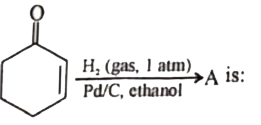Complete the following reaction.
CH3−CH2−CH2−C∣∣O−CH3HO−CH2−CH2−CH2−OH−−−−−−−−−−−−−−−−−−→H ?
Topper's Solved these Questions
- CARBONYL COMPOUNDS AND CARBOXYLIC ACIDSBOOK - PREMIERS PUBLISHERSCHAPTER - CARBONYL COMPOUNDS AND CARBOXYLIC ACIDSEXERCISE - OTHER IMORTENT QUESTIONS & ANSWERS ( CHOOSE THE CORRECT ANSWER.)
29 Videos
- CARBONYL COMPOUNDS AND CARBOXYLIC ACIDSBOOK - PREMIERS PUBLISHERSCHAPTER - CARBONYL COMPOUNDS AND CARBOXYLIC ACIDSEXERCISE - OTHER IMORTENT QUESTIONS & ANSWERS (ANSWER THE FOLLOWING QUESTIONS)
88 Videos
- CARBONYL COMPOUNDS AND CARBOXYLIC ACIDSBOOK - PREMIERS PUBLISHERSCHAPTER - CARBONYL COMPOUNDS AND CARBOXYLIC ACIDSEXERCISE - EVALUTION (TEXTBOOK QUESTIONS & ANSWERS) (CHOOSE THE CORRECT ANSWER)
25 Videos
- BIOMOLECULESBOOK - PREMIERS PUBLISHERSCHAPTER - BIOMOLECULESEXERCISE - OTHER IMPORTANT QUESTIONS& ANSWERS (Answer the following questions)
66 Videos
- CHEMICAL KINETICS BOOK - PREMIERS PUBLISHERSCHAPTER - CHEMICAL KINETICS EXERCISE - OTHER IMPORTANT QUESTIONS & ANSWERS (II. Answer the following questions.)
52 Videos
Similar Questions
The IUPAC name of the compound is

View SolutionWrite the IUPAC names of the following :

(iii) CH3CH2C∣∣OCH2CHO
(iv) CH3CH=CHCHO
View SolutionThe correct structure of the product ' A ' formed in the recation
 is:
is:
View SolutionWhat are monosaccharides?
View SolutionExpress the rate of the following reaction interms of disappearance of the reactant and appearance of formation of the product: A→B.
View SolutionI. CH3−CH2−CH2−CH2−OH
II. CH3−CH2−CH∣OH−CH3
III. CH3−CH3∣C∣OH−CH3
IV. CH3−CH∣CH3−CH2−OH
V. CH3−CH2−O−CH2−CH3
VI. CH3−O−CH2−CH2−CH3
VII. CH3−O−CH∣CH3−CH3
Which of the above compounds form pairs of metamers ?
View SolutionI. CH3−CH2−CH2−CH2−OH
II. CH3−CH2−CH∣OH−CH3
III. CH3−CH3∣C∣OH−CH3
IV. CH3−CH∣CH3−CH2−OH
V. CH3−CH2−O−CH2−CH3
VI. CH3−O−CH2−CH2−CH3
VII. CH3−O−CH∣CH3−CH3
Identify the pairs of compounds which are functional group isomers
View SolutionI. CH3−CH2−CH2−CH2−OH
II. CH3−CH2−CH∣OH−CH3
III. CH3−CH3∣C∣OH−CH3
IV. CH3−CH∣CH3−CH2−OH
V. CH3−CH2−O−CH2−CH3
VI. CH3−O−CH2−CH2−CH3
VII. CH3−O−CH∣CH3−CH3
Identify the pairs of compounds that represents position isomerism.
View SolutionI. CH_(3) - CH_(2) - CH_(2) - CH_(2) - OH II. CH_(3) - CH_(2) - underset(OH)underset(|)(CH) - CH_(3) III. CH_(3) - underset(OH) underset(|)overset(CH_(3))overset(|)(C) - CH_(3) IV. CH_(3) - underset(CH_(3))underset(|)(CH) - CH_(2) - OH V. CH_(3) - CH_(2) - O - CH_(2) - CH_(3) VI. CH_(3) - O - CH_(2) - CH_(2) - CH_(3) VII. CH_(3) - O - underset(CH_(3))underset(|)(CH) - CH_(3) Identify the pair of compounds that represents chain isomerism
View SolutionThe order of reactivity of following alcohols with halogen acids is _____ (A). CH_(3)CH_(2)-CH_(2)-OH (B). CH_(3)CH_(2)-underset(CH_(3))underset(|)(C)H-OH (C). CH_(3)CH_(2)-underset(CH_(3))underset(|)overset(CH_(3))overset(|)(C)-OH
View SolutionComplete the following reaction.
CH3−CH2−CH2−C∣∣O−CH3HO−CH2−CH2−CH2−OH−−−−−−−−−−−−−−−−−−→H+?
View SolutionCH_(3)-CH_(2)-CH_(2)-underset(OH)underset(|)(C )H-CH_(3) and CH_(3)-CH_(2)-underset(OH)underset(|)(C )H-CH_(2)-CH_(2)-CH_(3) are
View SolutionName the following compounds according to IUPAC system. (i) CH_(3) - CH_(2) - underset (CH_(2)Cl) underset(|)(CH) - overset (CH_(2)OH) overset(|) (CH) - underset (CH_(3)) underset (|) (CH) - CH_(3) CH_(3)- underset (CH_(3)) underset(|) (CH) -CH_(2) - underset(OH) underset(|) (CH) - overset (CH_(2)OH) overset(|) (CH) - CH_(2) (iii) (iv) H_(2)C = CH - underset (OH)underset (|) (CH) - CH_(2) - CH_(2) - CH_(3) (v) CH_(3) - underset (CH_(3)) underset ( |) C = underset (Br)underset(|) C - CH_(2)OH
View SolutionComplete the following reactions, CH_(3)-CH_(2) -CH_(2) - underset(O)underset(||)O -CH_(3) overset(HO -CH_(2) - CH_(2) -OH)underset(H^(+)) to
View SolutionThe order of reactivity of following alcohols with halogen acids is ………
(A) CH3CH2−CH2−OH
(B) CH3CH2−C | CH3H−OH
(C ) CH3CH2−CH3| C | CH3−OH
View SolutionI. CH3−CH2−CH2−CH2−OH
II. CH3−CH2−CH∣OH−CH3
III. CH3−CH3∣C∣OH−CH3
IV. CH3−CH∣CH3−CH2−OH
V. CH3−CH2−O−CH2−CH3
VI. CH3−O−CH2−CH2−CH3
VII. CH3−O−CH∣CH3−CH3
Which of the above compounds form pairs of metamers ?
View Solution

